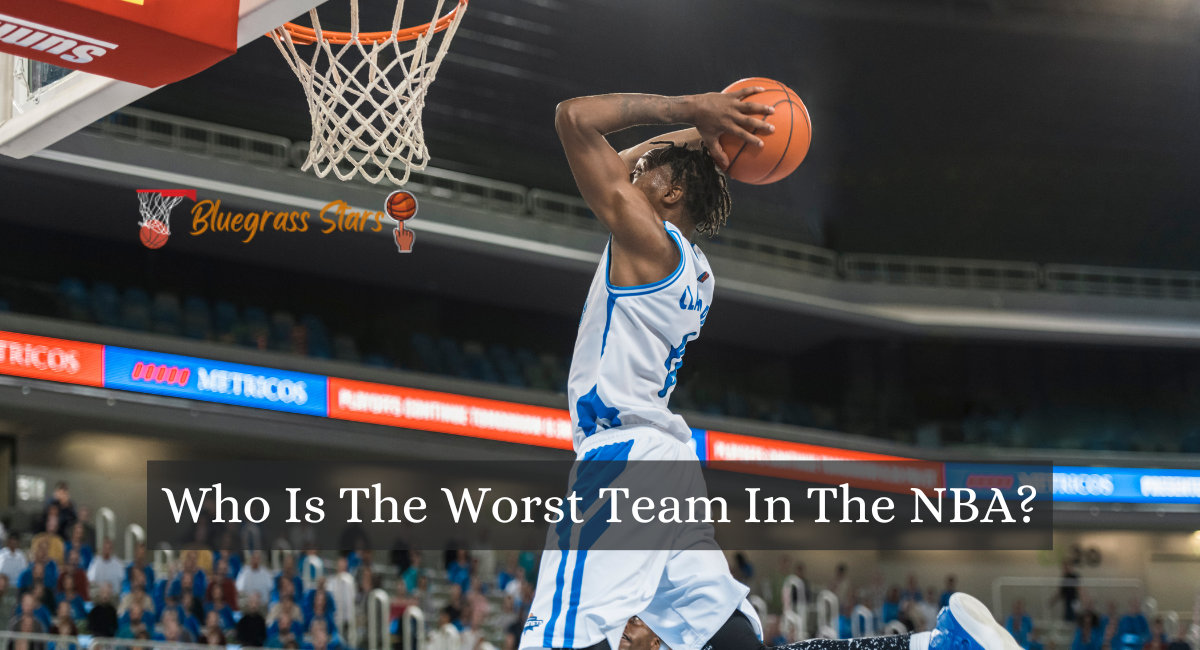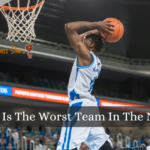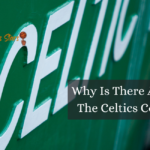Determining the “worst” team in the NBA is a matter of subjectivity contingent upon the criteria employed, including player statistics, overall performance metrics, or the current season’s win-loss record. Nevertheless, within the perpetually competitive NBA environment, this unwelcome label is frequently affixed to the team with the lowest standings at any particular moment.
This condition may occur due to many issues, including injuries, reconstruction periods, and substantial alterations in team rosters and management. Irrespective of this, every NBA team possesses its devoted fan base and instances of brilliance; a stretch of poor performance is frequently a component of their ongoing narrative.
Who Is The Worst Team In The NBA?
The NBA Finals have been determined, and it will be a contest between the Miami Heat and the Denver Nuggets to determine the defending champion of the National Basketball Association. Although the sporting world will be preoccupied with that series, Complex remains committed to recap the entire season comprehensively.
Our analysis of the season’s top guards and centers and our weekly power rankings for both the regular season and the postseason have been previously disseminated.
5. San Antonio Spurs
Despite having the worst record in the Western Conference, the San Antonio Spurs are ranked this high (or low, depending on your perspective) on this list due to the NBA Draft Lottery victory they secured with their 22 losses. They will most certainly select a “once in a generation” wunderkind. Victor Wembanyama was set number one. This was the fourth consecutive season in which the Spurs failed to qualify for the playoffs, and legendary coach Gregg Popovich’s 22-60 record is his worst since taking over the franchise in 1996.
There were a few bright points. Keldon Johnson, in his fourth season, led the team in scoring with 22 points each game. Devin Vassell, a third-year guard, also achieved career-highs in points (18.5) and field goal percentage (43.9), but that was about it. San Antonio finished as the last-place team in terms of field goals (46.5), three-pointers (34.5), points scored (113), plus-minus (-10), and defensive rating.
Additionally, the team conceded the most points (123.1) during the season and accumulated the worst point differential (-832). The Spurs surrendered the most points in a game under Coach Pop when they were defeated 151-131 by the Minnesota Timberwolves. Furthermore, with a losing streak of 16 consecutive games, they had the longest road record in the league (8-33), which was tied for first place (or last, depending on your perspective). However, they own the first overall selection in the current draft—limited victories for the Spurs, who play in a small market.
4. Portland Trail Blazers
A season in which Damien Lillard led Portland to 33 victories was an improvement over the previous campaign’s 27 victories. Still, a season in which the Cougars completed 33 games deserves recognition on this list. Although Dame Time recorded his highest-scoring season in eleven years (32.2ppg), highlighted by an incredible 71-point performance, the Blazers finished near the bottom of the league in terms of field goals made (27th), rebounding (28th) and plus-minus (26th).
Additionally, they were a liability on defense, ranking 27th in rating and 29th in three-point percentage against opponents. Aside from the debilitating impact of injuries, Portland lacked the necessary talent to surround their devoted superstar. This offseason is, therefore, crucial for the franchise.
Conversations circulating loudly regarding their potential consideration of trading the third overall pick in the current draft for a star to complement Lillard are noteworthy. The Blazers may also bid farewell to Dame, trade him for additional draft capital (such as to the Brooklyn Nets), and rely on five-year guard Anfernee Simons as the team’s new face in the reconstruction process. Simons averaged 21.1 points on 44.7 shooting, which is also a career-high.
3. Charlotte Hornets
The team owned by Michael Jordan entered the 2022-23 season with some optimism following their 43-39 record in the previous season, marking their first season of 40 victories since 2015. LaMelo Ball’s sustained development was a season highlight; he averaged career-highs in points (23.3) and assists (8.4) and finished his three-year career as the second-youngest player to amass 1,000 points, rebounds, and nurses, trailing only LeBron James.
Ball, however, appeared in only 36 games for the Hornets before being sidelined with a fractured ankle and ending the season. Those expectations were dashed for the Queen City. Despite the efforts of Kelly Oubre (20.3ppg), Terry Rozier (21.1ppg), and the frequently injured Gordon Hayward (14.7ppg), it was inconsequential. The Hornets concluded the season with a 27-55 record, which ranked them second-worst in the Eastern Conference.
They were tied for last place in terms of field goal (45.7) and three-point (33) percentage. Furthermore, with a rating of 109.2, they were the worst offensive team in the league. However, as the Hornets currently hold the second overall choice in the NBA Draft scheduled for the following month, they may acquire a generational talent to complement a returning LaMelo: Alabama’s Brandon Miller or G-League star Scoot Henderson.
2. Houston Rockets
Three consecutive victories by the Rockets in the season’s final games destroyed any remaining hopes of securing the first overall selection in the 2023 NBA Draft. In addition, this group had suffered a 13-game losing streak throughout the season. Due to their late-season ferocity, they finished the regular season tied with the San Antonio Spurs for the Western Conference’s abysmal record of 22-60.
Although the Rockets finished fourth in rebounds and first in offensive boards (with rookie Jabari Smith and second-year big man Alperen Sengun combining for a career-high nine rebounds per game and four rebounds per game, respectively), they were either last or near last in every other statistical category. Houston finished the league with the lowest three-point percentage (32.7), the lowest assists per game (22.4), the 29th defensive rating, the 28th overall in terms of points scored (110.7), field goal shooting (45.7), and plus-minus (-7.9). Additionally, the team ranked 25th in free throw percentage (75.4) and ranked next to last in turnovers (16.2).
With a new coach in defensive-minded Ime Udoka, the fourth overall pick in the NBA Draft, Jalen Green and Kevin Porter, Jr.’s promising production at 22.1 points per game and 19.2 points per game, respectively, and persistent rumors regarding James Harden’s return to Houston, this young team’s final-season enthusiasm has the potential to yield positive results in the upcoming campaign.
1. Detroit Pistons
Sigh. Possessing the worst record in the league would increase the likelihood of securing the first overall selection in the draft lottery. Contrary to expectations, the Detroit Pistons finished this season with 17 victories and a 14 percent possibility of securing the fifth overall pick in the lottery. Twelve games into the new season, Cade Cunningham suffered a leg injury that ended his season and prevented him from playing again.
The point guard, who had been in the league for two seasons, had averaged 19.9 points and six assists since his inaugural season. However, his absence had a detrimental impact on the team, which suffered throughout the year. Two 11-game losing streaks, the third-worst performance in the league, the 28th rank in both offensive and defensive rating, the 29th position in points scored (110.3), the 25th position in turnovers (15.1), the 27th position in assists, and the 29th position in plus-minus were all season lowlights.
Due to the abject performance on the court, coach Dwane Casey was compelled to resign, and there is currently a lack of interest in the position. However, the new franchise owner can anticipate developing a returning Cunningham, two-guard Jaden Ivey (who recorded a respectable 16.3 points on 41 percent shooting as a rookie), and whoever they select in the draft the following month.
Amidst the ever-evolving NBA landscape, a team that finishes the season at the bottom of the standings does not inherently establish itself as “the worst.” It is frequently a component of a broader strategy to reconstruct for future success and represents a moment. The temporary nature of this label fails to encompass the potential of youthful players’ development, the ramifications of future trades, or the development of draft picks.
Thank you for reading……



